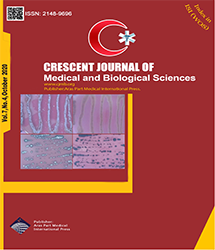
| Short Communication | |
| Relationship Between Android Obesity and Menstrual Disorders in Different Ages of the Menarche | |
| Naeimeh Tayebi1, Niloufar Izaddost2, Marzieh Akbarzadeh3 | |
| 1Department of Midwifery, School of Nursing and Midwifery, Bam University of Medical Sciences, Bam, Iran 2Department of Midwifery, Student Research Center, School of Nursing and Midwifery, Bam University of Medical Sciences, Bam, Iran 3Maternal-Fetal Medicine Research Center, Department of Midwifery, School of Nursing and Midwifery, Shiraz University of Medical Sciences. Shiraz, Iran |
|
|
CJMB 2020; 7: 568-572 Viewed : 5624 times Downloaded : 3134 times. Keywords : Adolescents, Age at menarche, Android obesity, Menstrual disorders, Students |
|
| Full Text(PDF) | Related Articles | |
| Abstract | |
Objectives: Obesity affects various aspects of puberty development, including the hormonal parameters and onset of puberty during puberty. Therefore, the purpose of this study was to investigate the relationship between android obesity and menstrual disorders in different ages of menarche. Materials and Methods: The present cross-sectional study adopted a cluster-sampling method to evaluate 2000 girls (aged 9-18) who were selected from all regions of Shiraz. Then, questionnaires were completed, including data on demographic characteristics, menstrual disorders, and the like. Then, their weight, height, waist, and the circumference of the hip were measured by the standard method, and finally, the data were analyzed by SPSS using statistical tests. Results: A number of 1945 (97.3%) out of 2000 girls had android obesity <0.85 and 55 (2.8%) of them suffered from android obesity >0.85. Based on the results, no significant relationship was observed between android obesity and bleeding duration (P = 0.09), menstrual cycle length (P = 0.76), amenorrhea (P = 0.98), dysmenorrhea (P = 0.31), spotting (P = 0.24), passing clots (P=0.35), menstrual regularity (P = 0.89), and menstrual bleeding (P = 0.08). However, a meaningful relationship was found between android obesity (P = 0.001) and body mass index (BMI). Conclusions: In general, most subjects did not have android obesity. Based on the results, there was a meaningful relationship between BMI and android obesity. However, no meaningful relationship was found between bleeding duration, passing clots, menstrual regularity, menstrual cycle length, amenorrhea, dysmenorrhea, spotting, and menstrual bleeding. Therefore, the necessity of paying more attention to adolescents in intervention programs and education is felt more than before in order to improve their nutritional status and health. |
Cite By, Google Scholar
Online Submission System
 CJMB ENDNOTE ® Style
CJMB ENDNOTE ® Style
 Tutorials
Tutorials
 Publication Charge
Medical and Biological Research Center
About Journal
Publication Charge
Medical and Biological Research Center
About Journal
Aras Part Medical International Press Editor-in-Chief
Arash Khaki
Deputy Editor
Zafer Akan


















